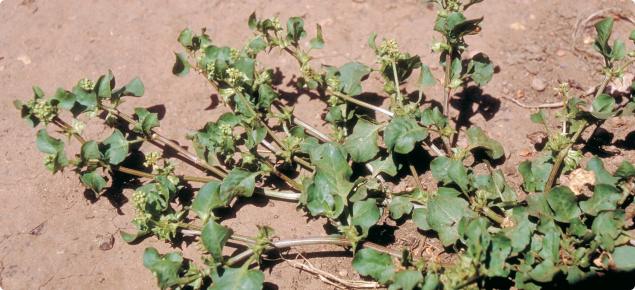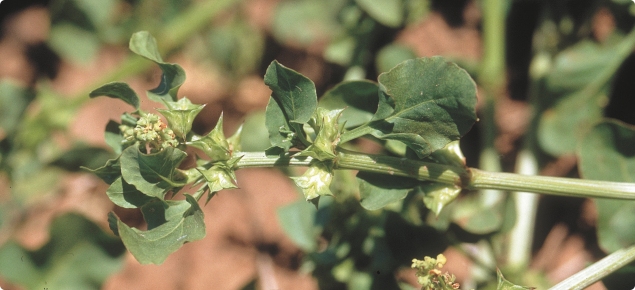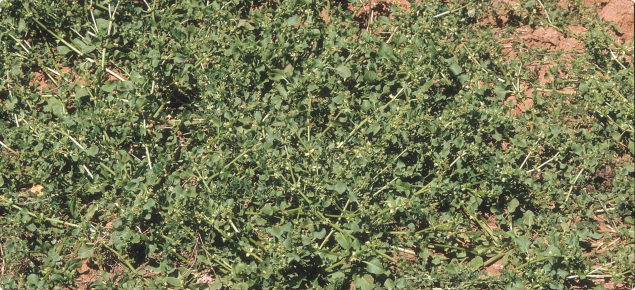Form: herbaceous — annual
Status: present in WA
Doublegee is native of South Africa.
Appearance
Hairless annual, usually prostrate but can grow taller among other plants.
Stems: mostly prostrate, to 50 centimetres long, several arising from the crown, hairless, ribbed, fleshy and purple at the base and nodes.
Leaves: triangular to oval, hairless, each leaf stalk surrounded by membranous sheath at the base.
Flowers: male and female flowers are separate and inconspicuous. The male flowers are in clusters on small stalks, while the female flowers are almost without a stalk and form in the leaf axils.
Fruit: woody and hard, 7 to 11 millimetres long and triangular in longitudinal cross section, each angle extending to rigid sharp spine. There are four pits on each face. Changes from green to brown when mature.
Seed: triangular and one per fruit.
Online weed identification training
Login or set up a new account on DPIRDs online training site to access:
- a training course on how to identify doublegee and report it.
- training material that you can use to teach community groups how to identify doublegee.
Agricultural and economic impact
Doublegee can infest crops and pastures. Its woody fruits can damage the feet of livestock, particularly lambs, and dogs. Doublegee plants can be toxic to livestock.
Declared pest category
The Western Australian Organism List (WAOL) contains information on the area(s) in which this pest is declared and the control and keeping categories to which it has been assigned in Western Australia (WA). Search for doublegee in the WAOL using the scientific name Emex australis.
Search > detect > record
| MyPestGuide™ Reporter | Pest and Disease Information Service (PaDIS) |
Detectability: easy to find. Doublegee plants have dark green leaves similar to English spinach. Emex australis is the most common and widespread of the two types of doublegee found in WA. It has distinctive woody fruits (achenes) each with three obvious spines arranged in such a way that one is always pointing upward. Emex spinosa is not as widespread and has smaller spines on its fruit. It has tiny inconspicuous greenish flowers.
Doublegee could be confused with caltrop (Tribulus terrestris), especially around Perth and larger regional centres. However, caltrop has fine fern-like greyish leaves and small yellow flowers (up to one centimetre across) with five petals. Caltrop plants are only found in summer and autumn. Caltrop is not a declared plant but is a pest plant in some shires.
Who is likely to find it: potentially anyone in the South West Land Division, including biosecurity groups, local governments, landholders and the general public.
When to find it: doublegee plants are most obvious in winter and spring, but they can grow at any time of year if suitable rainfall occurs.
Where to find it: doublegee are found throughout the South West Land Division. It can be found in crop and pasture paddocks, on roadsides and on any disturbed soils.
Control method
When using any agricultural chemicals please ensure that you always follow instructions on the label and any permit. Users of agricultural chemical products must always strictly comply with the directions on the label and the conditions of any permit.
Only registered products can be used for weed and pest control.
Control methods for this plant can be found through the APVMA website, use "doublegee" as the pest name.
Management calendar
a faded icon means occasionally




